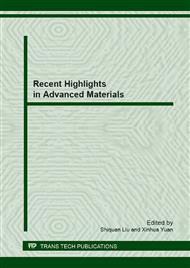p.499
p.504
p.510
p.515
p.519
p.523
p.527
p.531
p.535
Influence of Compound Bonding Agent on the Performance and the Microstructure of Proppant
Abstract:
Low-density proppants have been developed using two kinds of bauxites containing different ratios of aluminum as main raw materials and compound liquid as a binding agent. The influences of the amount of compound bonding agent and the sintering temperature on the performance of the proppant were studied. The phase composition of calcined sample was identified by X-ray diffraction (XRD) method. The microstructure of the sintered sample was characterized by scanning electron microscope (SEM). It is shown that the proppant prepared with increasing compound bonding agent can meet the national standard. With the increase of the sintering temperature, mullite with uniform grain size is formed.
Info:
Periodical:
Pages:
519-522
Citation:
Online since:
September 2013
Authors:
Keywords:
Price:
Сopyright:
© 2014 Trans Tech Publications Ltd. All Rights Reserved
Share:
Citation:


